Xiaomi 14 Ultra vs iPhone 15 Pro Max: A leap of faith
We may earn a commission if you make a purchase from the links on this page.

Intro
The Xiaomi 14 Ultra is officially out and climbing on top of different camera lists as we type this. It's a camera monster with little to no compromises, but at the same time, it's more expensive than an iPhone 15 Pro Max, which is not a thing to be taken lightly.
As far as ultra-premium flagships go, the Xiaomi 14 Ultra lives up to its name, but can this phone from the Far East be a real competitor to the aforementioned iPhone 15 Pro Max? Especially, given the fact that it's really hard to get a hold of one in the US.
In this article, we pit the Xiaomi 14 Ultra against the iPhone 15 Pro Max in order to give you the ultimate answer. Which one should you buy?
As far as ultra-premium flagships go, the Xiaomi 14 Ultra lives up to its name, but can this phone from the Far East be a real competitor to the aforementioned iPhone 15 Pro Max? Especially, given the fact that it's really hard to get a hold of one in the US.
UPDATE: Both the iPhone 16 Pro Max and the Xiaomi 15 Ultra are out now, so be sure to check out out detailed comparisons featuring the new flagships.
- Xiaomi 15 Ultra vs Galaxy S25 Ultra: The main differences between the two Ultra champs
- Samsung Galaxy S25 Ultra vs iPhone 16 Pro Max: The best phones right now
Xiaomi 14 Ultra vs iPhone 15 Pro Max differences explained:
| Xiaomi 14 Ultra | iPhone 15 Pro Max |
|---|---|
| Curved front and back | Flat front and back |
| Brighter display with higher resolution | Slightly smaller display (0.3-inches) |
| Four 50MP cameras, with two telephoto and an ultrawide | Three cameras with 48MP main, and 12MP telephoto and ultrawide |
| 12GB RAM in the base memory configuration, with up to 16GB for to top-tier version | Less RAM in all the memory configurations (8GB) |
| Under-display fingerprint scanner | FaceID |
| Larger 5,000mAh battery that will potentially deliver better battery life | A smaller 4,441mAh battery |
| Faster wired and wireless charging, 90W and 80W respectively | Slower charging with 50% in 30 min (advertised) |
| More expensive at 1,499 euros | Base model starts at $1,199 |
Table of Contents:
Design and Display Quality
Apples and tangerines
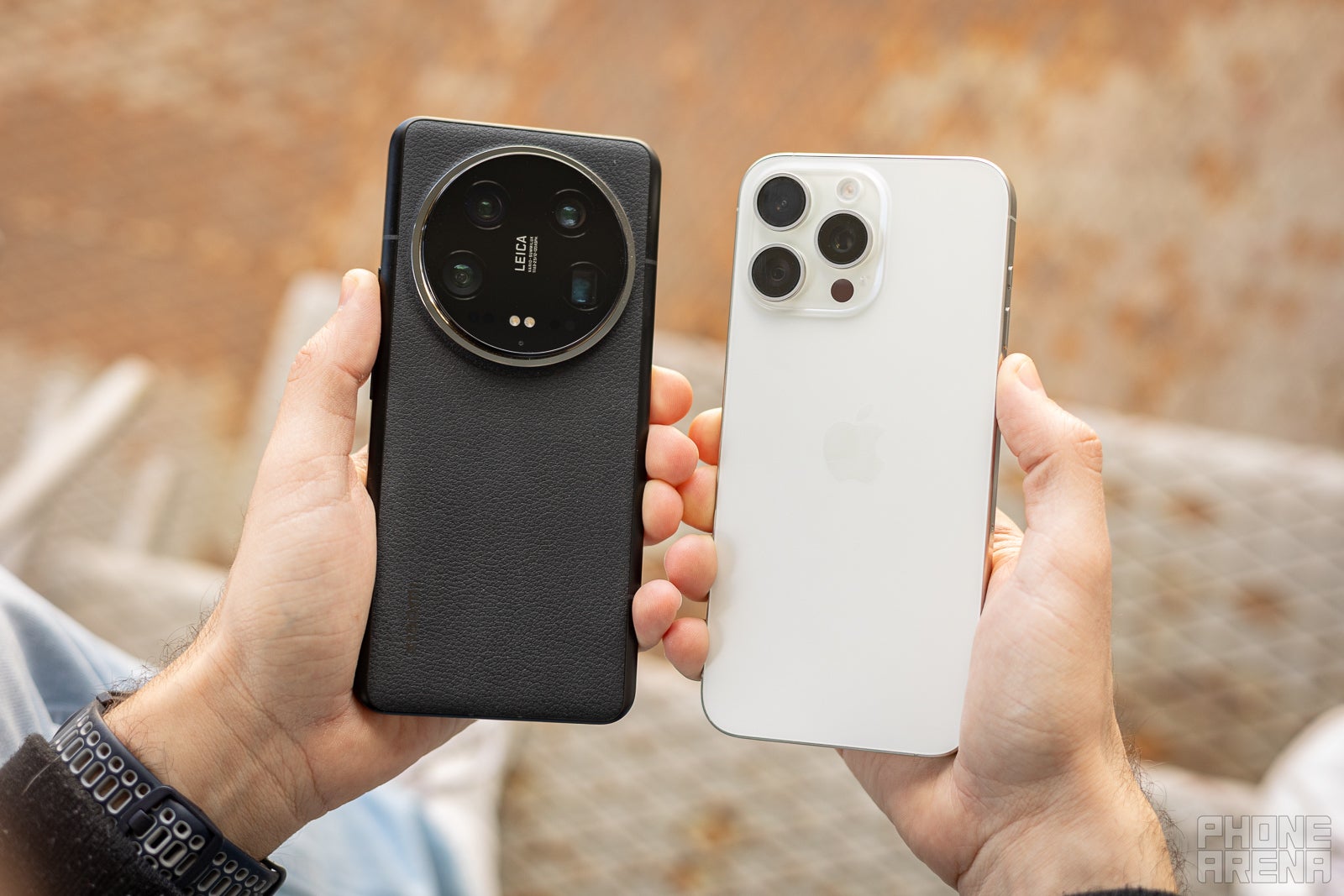
If you glance at the specs, you'll find that the Xiaomi 14 Ultra and the iPhone 15 Pro Max seem to be very similar. The screen size is almost the same on both devices, the weight is also within a couple of grams, both have titanium frames (the Xiaomi 14 Ultra has titanium as an option), and yet these are radically different in so many ways.
First, the feel in the hand is different. The Xiaomi 14 Ultra uses a curved design for its front and back, which makes it more compact and less wide compared to the extremely flat iPhone 15 Pro Max. This comes with pros and cons. On the one hand, it's easier to hold the Xiaomi 14 Ultra, but on the other hand, using the iPhone 15 Pro Max is easier thanks to the flat display.
The design differences continue when you turn both phones and look at their backs. The Xiaomi 14 Ultra relies on a huge circular camera bump, which, coupled with the camera grip accessory, gives the look and feel of a point-and-shoot camera. The iPhone 15 Pro Max looks… well, like every other iPhone since the 12-series.
Design is subjective, so you have to make up your own mind which one you like better, the leathery and curved, camera-like Xiaomi 14 Ultra, or the minimalistic flat and squarish iPhone 15 Pro Max.
The design differences continue when you turn both phones and look at their backs. The Xiaomi 14 Ultra relies on a huge circular camera bump, which, coupled with the camera grip accessory, gives the look and feel of a point-and-shoot camera. The iPhone 15 Pro Max looks… well, like every other iPhone since the 12-series.
Design is subjective, so you have to make up your own mind which one you like better, the leathery and curved, camera-like Xiaomi 14 Ultra, or the minimalistic flat and squarish iPhone 15 Pro Max.
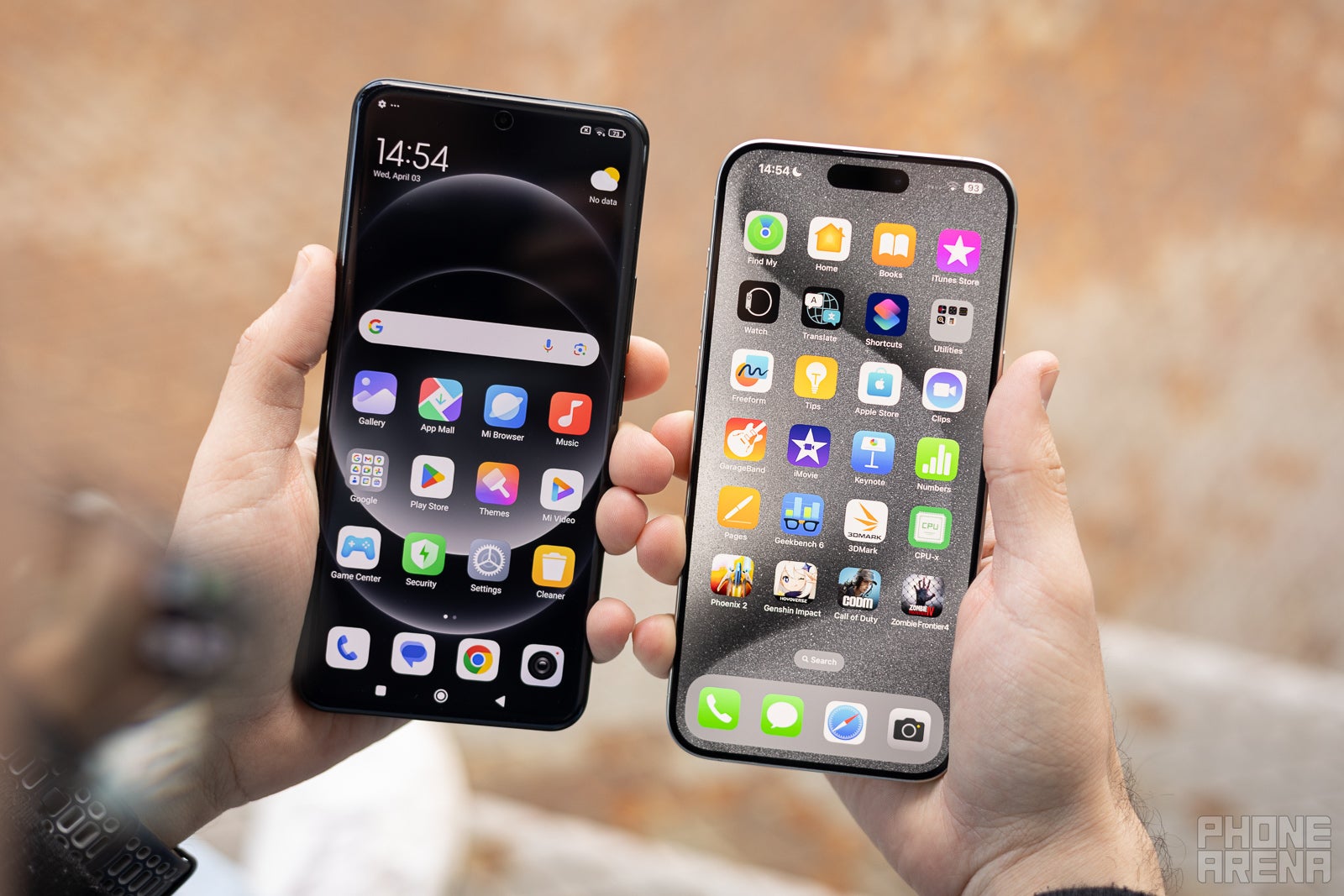
Moving to the display part, as we stated above, the screens of the Xiaomi 14 Ultra and the iPhone 15 Pro Max may seem similar on paper, but they are very different in reality. For one, the slightly curved display of the Xiaomi 14 Ultra feels radically different than the flat panel on the iPhone 15 Pro Max. And even though the curvature is very, very subtle, it's still there.
The other difference lies in the resolution. The Xiaomi has a 1440p screen (1440 x 3200 pixels), translating into a pixel density of around 522 PPI, while the iPhone comes with a 1290 x 2796 resolution and 460 PPI. In reality, you won't be able to tell the difference, as both screens are crisp and sharp.
Both screens can do 1-120Hz dynamically, and both feature very high brightness numbers, with the Xiaomi winning on paper with its 3,000 nits versus the 2,000 nits on the iPhone. Our lab tests showed that both panels are very close in terms of brightness and color accuracy. At the end of the day it all boils down to whether you like a curved or a flat screen.
The other difference lies in the resolution. The Xiaomi has a 1440p screen (1440 x 3200 pixels), translating into a pixel density of around 522 PPI, while the iPhone comes with a 1290 x 2796 resolution and 460 PPI. In reality, you won't be able to tell the difference, as both screens are crisp and sharp.
The biometrics involved are very different. The iPhone 15 Pro Max relies on the FaceID and its sophisticated 3D mapping, while there's an optical fingerprint scanner tucked under the display of the Xiaomi 14 Ultra. Both work well, but we like the FaceID option on the iPhone 15 Pro Max better, as it's more secure, more consistent, and requires less effort.
Performance and Software
Benchmark wars

Both the Xiaomi 14 Ultra and the iPhone 15 Pro Max use top silicon as a beating heart. It's Qualcomm's top Snapdragon 8 Gen 3 chipset inside the Xiaomi, and the A17 inside the iPhone. It's hard to compare these two purely using synthetic benchmarks (although they are pretty close there too), mainly because both use different hardware and software (with different philosophy behind both of these things).
For example, the Xiaomi 14 Ultra can be bought with 16GB of RAM, twice as much as what the iPhone 15 Pro Max has, but in reality, you won't notice much of a difference between the two. The real-life performance is stellar on both phones, and if you don't like to spend your evening staring at synthetic benchmark scores, we can tell you that you will get top-notch performance out of either of these phones.
For example, the Xiaomi 14 Ultra can be bought with 16GB of RAM, twice as much as what the iPhone 15 Pro Max has, but in reality, you won't notice much of a difference between the two. The real-life performance is stellar on both phones, and if you don't like to spend your evening staring at synthetic benchmark scores, we can tell you that you will get top-notch performance out of either of these phones.
Performance Benchmarks:
When it comes to software, the most important thing to mention is support. We all know it's Android versus iOS in this case, and both have pros and cons, but the iPhone 15 Pro Max has a longer support cycle with five years of software updates, while the Xiaomi 14 Ultra gives you four. It's not a night and day difference, and many people won't hold on to their phones for that long, but it's a point worth mentioning.
Camera
More is more?
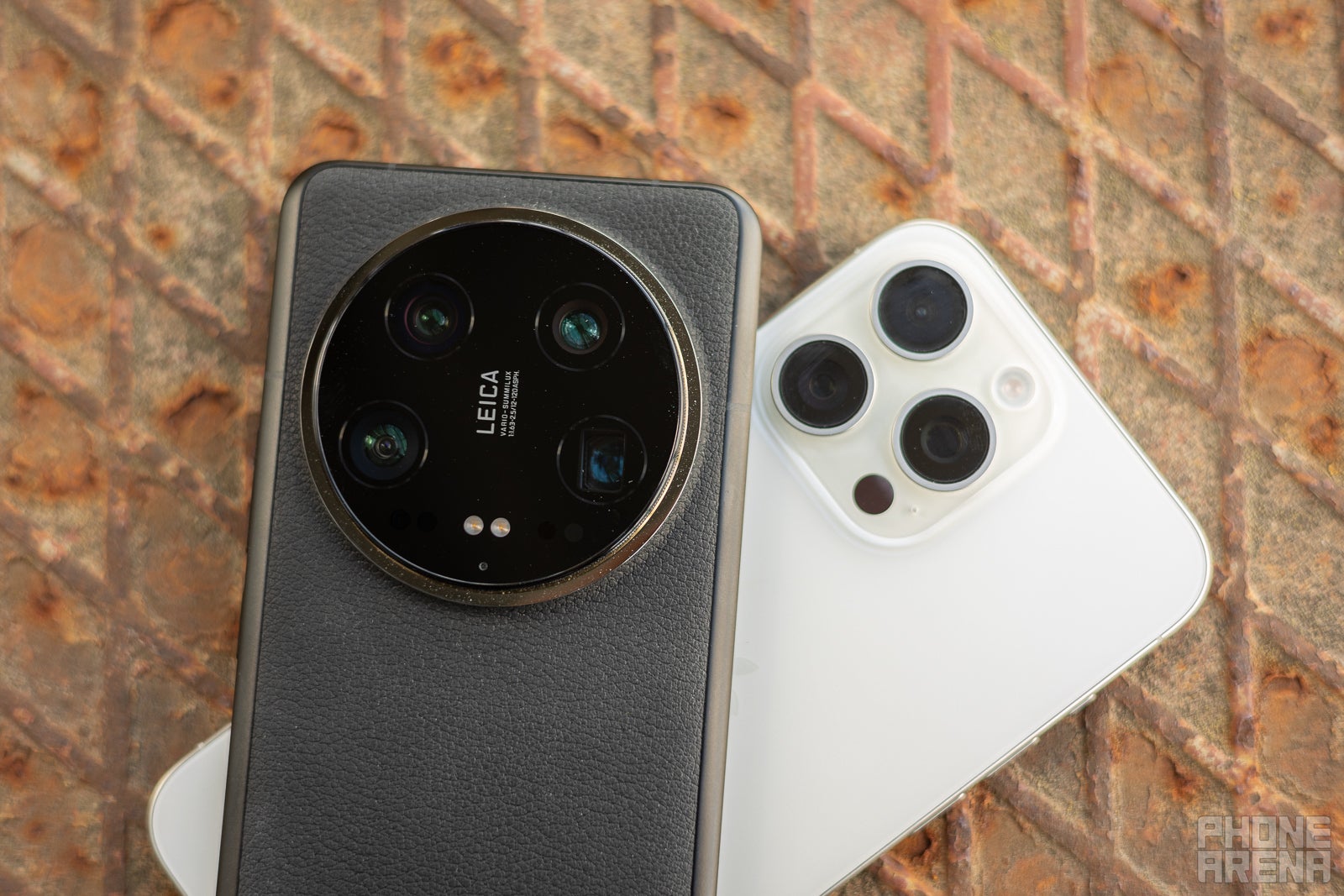
The Xiaomi 14 Ultra comes with a very potent camera system. The main camera uses a 50MP, 1" sensor with a variable f/1.6–4.0 aperture and a 23mm focal length equivalent. The ultrawide camera is also 50MP, as are the two telephoto cameras, one with a 3.2x optical zoom and the other (persicope) with 5x optical.
The iPhone 15 Pro Max is less impressive on paper with its 48MP, 1/1.28" main sensor, and 12MP ultrawide and telephoto, but we all know that algorithms play a huge part in modern computational photography, so we need some samples to make a real-life comparison. And you will find those below!
The iPhone 15 Pro Max is less impressive on paper with its 48MP, 1/1.28" main sensor, and 12MP ultrawide and telephoto, but we all know that algorithms play a huge part in modern computational photography, so we need some samples to make a real-life comparison. And you will find those below!
Main Camera
It's funny how subjective things may be in life. In our Xiaomi 14 Ultra vs Galaxy S24 Ultra comparison, we said that the Xiaomi displayed much warmer colors. But here, compared to the iPhone 15 Pro Max, the Xiaomi samples look colder. Which goes to show how much warmer the iPhone 15 Pro Max really is. Also, even though both phones deliver truly awesome photos, it looks like the iPhone is able to preserve more details (if you take a look at the clouds).
Now the low-light situation paints a different picture. The Xiaomi 14 Ultra seems to be applying more HDR stacking in order to brighten the image and resolve more detail. This leads to overall clearer pictures, although they sometimes tend to look unnatural. The iPhone 15 Pro Max, on the other hand, does a decent job as well, but sometimes there's trouble with bright artificial lights.
Zoom Quality
At 3.2x and 3x zoom respectively, both phones perform very close, which carries over at 5x magnification. Very similar detail levels, and image quality with again difference in tonality. At 10x, however, the iPhone 15 Pro Max kind of produces a better image, sharper and clearer. Not that the sample from the Xiaomi 14 Ultra is bad or something, but we do like the one from the iPhone better. Overall, they are very close and you won't be disappointed no matter which one you choose, if zoom shots are your thing.
Ultra-wide Camera
Looking at the ultrawide samples, both phones did a great job, resolving details and offering a decent dynamic range for a ultrawide camera, but the sample from the iPhone looks overly processed and the sky looks too HDR for our personal taste. The image from the Xiaomi looks more natural. What do you think? Which one you like better?
Selfies
The selfie sample from the iPhone 15 Pro Max looks better to us, with more details, and natural tone to it. Just like in the Galaxy S24 Ultra comparison, the Xiaomi tends to produce softer and washed-out selfies, and there might be some beautify algorithm at play in the background, even though we turned that off. Overall, if you snap a lot of selfies, the iPhone 15 Pro Max is the better selfie machine here.
Video Quality

Here's our video comparison between the iPhone 15 Pro Max and the Xiaomi 14 Ultra with some still images sprinkled here and there for good measure. What do you think? Which one takes the video crown?
Audio Quality and Haptics
When it comes to audio quality, both phones are in the same ballpark. Both the Xiaomi 14 Ultra and the iPhone 15 Pro Max use a stereo speaker setup with one bottom firing loudspeaker and the earpiece doubling as a second speaker.
Both phones can get decently loud and sound good, but it seems that the iPhone 15 Pro Max is a tad louder and clearer. Neither of these have a 3.5mm audio jack, so no wired audiophile-grade headphones (at least not without an adapter).
Haptics are strong and tight on both phones, again, we have a slight preference for the iPhone 15 Pro Max, as its Taptic Engine delivers smoother and more satisfying vibrations.
Both phones can get decently loud and sound good, but it seems that the iPhone 15 Pro Max is a tad louder and clearer. Neither of these have a 3.5mm audio jack, so no wired audiophile-grade headphones (at least not without an adapter).
Battery Life and Charging
Poweeeeeeeer!
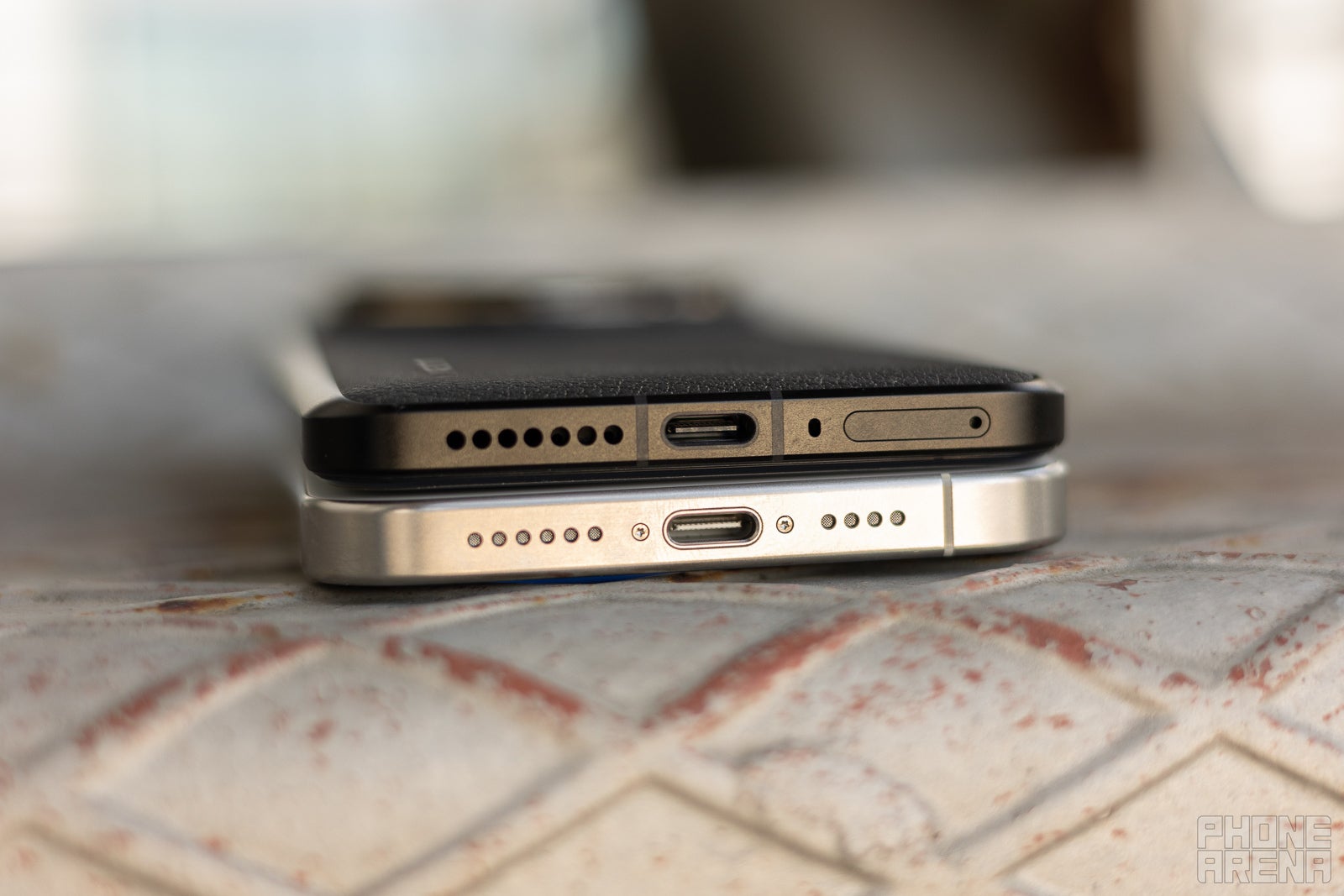
There's a theoretical advantage for the Xiaomi 14 Ultra in this category, as it sports a larger battery (5,000 mAh) compared to the iPhone (4,441 mAh). Theoretical doesn't always translate to the same result in practice and this is the case with the iPhone and the Xiaomi. Even though the latter sports a larger battery, during our tests the iPhone was able to beat the Xiaomi in every category. The difference isn't huge if we take a look at our streaming and gaming tests, but browsing at a dynamic refresh rate seems to be an issue for the Xiaomi 14 Ultra.
When we move to the charging, things are even more polarized, the Xiaomi can pump up 90W of power into its battery, while the iPhone caps at 25W. This leads to a huge difference in charging times, and it's not in favor of the iPhone. The Xiaomi obliterates the iPhone when it comes to fast charging, managing to fill up its larger battery in just 45 minutes.
Specs Comparison
For the geeky part of our audience, here's a tiny specs comparison table. You can check out the detailed Xiaomi 14 Ultra vs iPhone 15 Pro Max specs comparison if you want to dig deeper.
| Specs | PHONE1 | PHONE2 |
|---|---|---|
| Dimensions | 161.4 x 75.3 x 9.2 mm | 159.9 x 76.7 x 8.3 mm |
| Weight | 219.8 g | 221 g |
| Screen | 6.73-inch AMOLED 120Hz | 6.7-inch OLED 120Hz |
| Processor | Qualcomm Snapdragon 8 Gen 3 (4nm) | Apple A17 Pro (3nm) |
| RAM, Storage and Price | 12/256GB for 1,499 euros | 8/256GB for $1,199 |
| Cameras | 50MP main, f/1.6-4.0 50MP ultra-wide, f/1.8 50MP telephoto, 3.2x 50MP periscope, 5x 32MP front | 48MP main, f/1.8 12MP ultra-wide, f/2.2 12MP telephoto, f/2.8 12MP front |
| Battery Size | 5,000 mAh | 4,441 mAh |
| Charging Speeds | 90W wired 80W wireless 10W reverse | 25W wired 15W wireless |
Which one wins the battle?
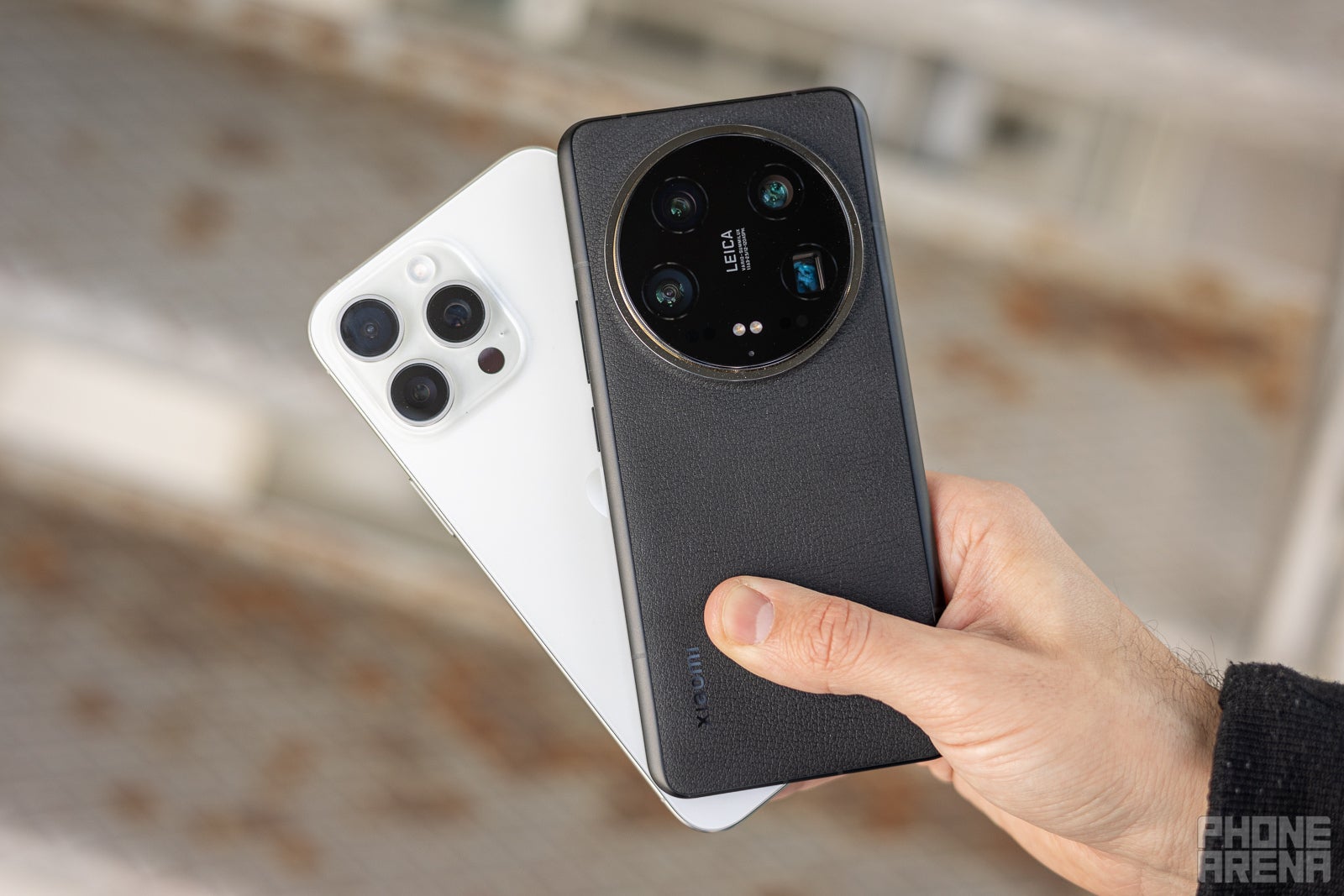
This is the ultimate question, isn't it? And the answer is not always down to objective specs comparisons or even samples and benchmarks. There are a lot of bells and whistles on the Xiaomi 14 Ultra, it's a true camera phone with a gorgeous display and insanely fast charging.
But you have to part with a pile of cash to get one (over $1,600 equivalent), not to mention the troubles of buying one in the US. And at the end of the day, this leap of faith might not be justified. To be fair to Xiaomi, you won't regret buying the Xiaomi 14 Ultra, and owning this phone in the US will make you stand out in the crowd.
Getting the iPhone 15 Pro Max is the safe choice, of course. You're getting something tried and tested, something familiar, and something that will last longer and resell better. Furthermore, now that the iPhone 16 series has landed, you can probably get the 15 Pro Max on a good deal, or even go for the the next generation, considering the price of the Xiaomi 14 Ultra.
There's also a new Xiaomi 15 lineup (review pending) coming our way with promises to bring all the cools stuff the Ultra has (there's a Xiaomi 15 Ultra model globally again, yey), so that's another thing to consider.
But you have to part with a pile of cash to get one (over $1,600 equivalent), not to mention the troubles of buying one in the US. And at the end of the day, this leap of faith might not be justified. To be fair to Xiaomi, you won't regret buying the Xiaomi 14 Ultra, and owning this phone in the US will make you stand out in the crowd.
Getting the iPhone 15 Pro Max is the safe choice, of course. You're getting something tried and tested, something familiar, and something that will last longer and resell better. Furthermore, now that the iPhone 16 series has landed, you can probably get the 15 Pro Max on a good deal, or even go for the the next generation, considering the price of the Xiaomi 14 Ultra.
There's also a new Xiaomi 15 lineup (review pending) coming our way with promises to bring all the cools stuff the Ultra has (there's a Xiaomi 15 Ultra model globally again, yey), so that's another thing to consider.
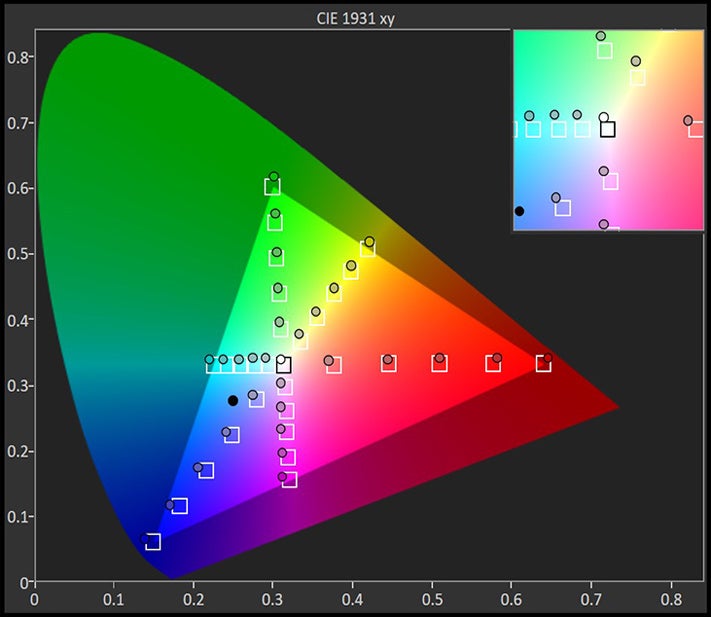




























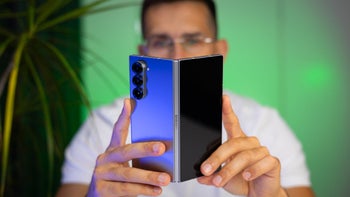









Things that are NOT allowed: